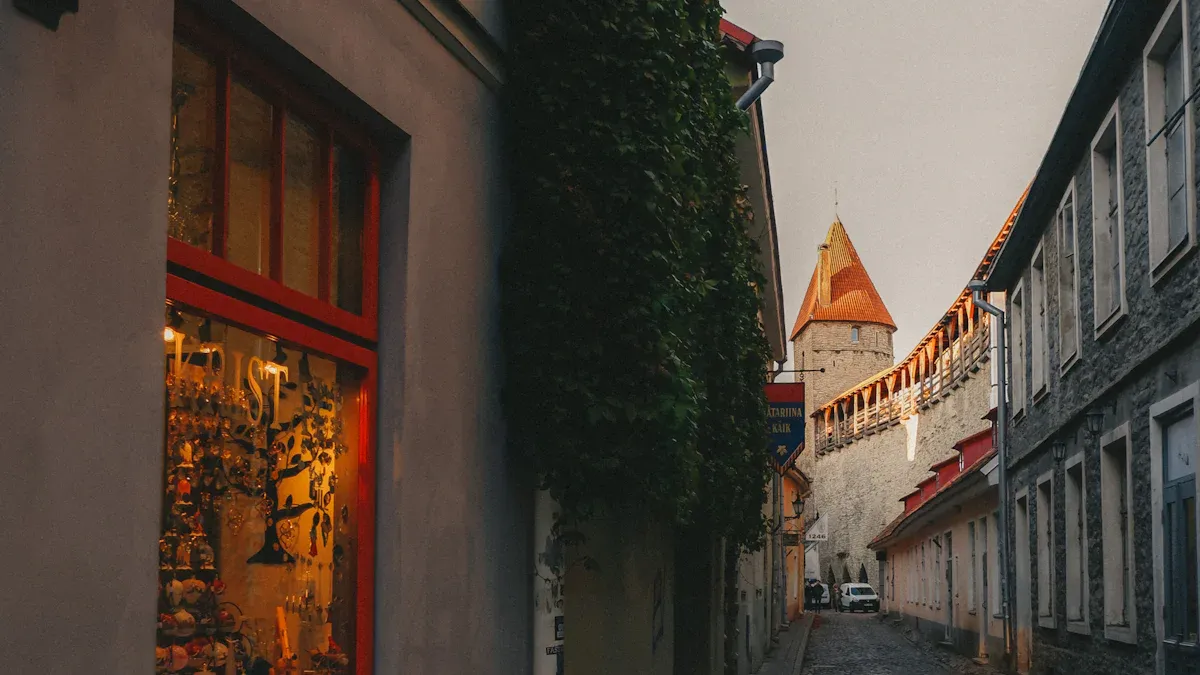How to Choose the Right Flashlight for Your Outdoor and Urban Adventures

A flashlight is more than just a tool; it’s your trusted companion when the sun goes down. Whether you’re hiking through dense woods or walking home late at night, the right light can make all the difference. Choose the right flashlight, like the reliable helius flashlight, to stay prepared for any situation.
Key Takeaways
A good flashlight is important for staying safe outside or in cities. It helps you see in the dark and ask for help if needed.
When picking a flashlight, think about how bright it is (lumens), how long the battery lasts, and how strong it is. These things make sure the flashlight works for you.
Choose flashlights that can change beam size and have different settings. This makes it easier to use in many situations.
Why You Need a Flashlight for Outdoor and Urban Adventures
Safety and Emergency Preparedness
A flashlight is your first line of defense when things go wrong. Imagine hiking at dusk and suddenly losing your way. A tactical flashlight with high lumen output can help you find the trail or signal for help. It’s also a lifesaver during emergencies like power outages or car breakdowns. If you’re stranded at night, a flashlight can help you change a tire or alert others to your location. Its reliability ensures you’re prepared for unexpected situations, whether you’re in the city or the wilderness.
Convenience in Low-Light Conditions
Navigating in the dark can be tricky, but a flashlight makes it easier. Whether you’re camping under the stars or walking through a dimly lit alley, having a dependable light source is essential. A camping flashlight, for instance, can illuminate your tent or guide you to the restroom at night. In urban settings, a compact tactical flashlight fits in your pocket and provides quick access to light when you need it most. It’s all about making your outdoor adventures and daily life more manageable.
Versatility Across Different Activities
Flashlights are incredibly versatile tools. They’re not just for emergencies. First responders use them during nighttime rescue missions, while hikers rely on them to navigate rugged trails. If you’re camping, a flashlight is perfect for setting up your gear after sunset. It’s also handy for signaling distress or calling for help when other light sources fail. From hiking to urban exploration, a flashlight adapts to your needs, making it an essential part of your gear.
Key Features of a Quality Tactical Flashlight

Brightness (Lumens) and Beam Distance
When choosing a tactical flashlight, brightness and beam distance are two of the most important factors. You might wonder, "How many lumens do I need?" The answer depends on your activities. A flashlight with a high lumen output provides intense light, perfect for outdoor adventures or emergencies. Beam distance also matters. A focused beam can help you spot hazards or objects from far away, while a flood beam lights up a wide area for close-range tasks. Some flashlights even offer adjustable beams, giving you the flexibility to switch between flood and spot modes depending on your needs.
Battery Life and Power Options
Battery life determines how long your flashlight will last during use. High-quality tactical flashlights often feature different power options, such as rechargeable or disposable batteries. Rechargeable batteries are eco-friendly and cost-effective, while disposable ones are convenient for extended trips. Here’s a quick comparison of common battery types:
Battery Type | Typical Life (Cycles) | Characteristics |
|---|---|---|
Nickel-Cadmium (NiCd) | 1,000 | Durable but less energy-dense. |
Nickel-Metal Hydride (NiMH) | 1,000+ | Offers longer runtime than NiCd. |
Lithium-Ion (Li-Ion) | 500 | Lightweight and powerful but fewer charge cycles. |
Capacitor | 50,000 | Charges quickly but discharges faster. |
Durability and Weather Resistance
A tactical flashlight must withstand tough conditions. Durable construction, such as anodized aluminum or reinforced plastic, ensures it can handle drops and impacts. Look for flashlights with an IP67 rating or higher for water resistance. This means they can survive rain or even brief submersion. Additionally, corrosion-resistant coatings protect against rust, maintaining functionality in humid environments. These features make your flashlight reliable in any situation.
Size, Weight, and Portability
Portability is key when you’re on the move. A compact and lightweight flashlight fits easily in your pocket or backpack without adding bulk. Tactical flashlights strike a balance between size and power, ensuring they’re easy to carry while still delivering excellent performance. Whether you’re hiking, camping, or navigating urban streets, a portable flashlight is a must-have.
Beam Type: Flood vs. Spot
The type of beam your flashlight produces affects its usability. Flood beams illuminate a wide area, making them ideal for camping or lighting up large spaces. Spot beams, on the other hand, focus light into a narrow, intense beam, perfect for long-distance tasks like search and rescue. Some flashlights offer adjustable beams, letting you switch between flood and spot modes for maximum versatility. This flexibility ensures your flashlight adapts to any scenario.
Types of Flashlights and Their Uses

Tactical Flashlights for Emergencies
Tactical flashlights are your go-to tool for emergencies. These flashlights are built to perform under pressure, offering features that make them indispensable in critical situations:
High Brightness Output: They deliver intense light, helping you illuminate dark areas or temporarily blind an attacker.
Durability: Made from tough materials, they’re waterproof and shockproof, ensuring they work even in harsh conditions.
Ergonomic Design: Many models include a tail cap switch for quick, one-handed operation.
Multiple Modes: You can switch between brightness levels or use strobe and SOS modes for signaling.
Self-Defense Features: Some tactical flashlights have a crenelated bezel, which can serve as a non-lethal self-defense tool.
Compact and portable, these flashlights are easy to carry, making them a reliable companion for both urban and outdoor emergencies.
Headlamps for Hands-Free Activities
If you need both hands free, headlamps are the perfect solution. They’re lightweight and comfortable, making them ideal for tasks like cooking at a campsite or setting up a tent in the dark. A headlamp provides consistent light wherever you look, so you don’t have to adjust it constantly. Whether you’re hiking, climbing, or working on a project, a headlamp ensures you can focus on the task at hand without juggling a flashlight.
Everyday Carry (EDC) Flashlights for Urban Use
For urban environments, everyday carry (EDC) flashlights are a must. These compact tools fit easily in your pocket or bag, so you’ll always have light when you need it. Despite their small size, EDC flashlights pack a punch, offering brightness levels ranging from 150 to 3000 lumens. They’re also built to last, with durable materials like anodized aluminum and waterproof designs. Many models include rechargeable batteries, giving you long-lasting power for daily use. Whether you’re navigating a dark parking lot or dealing with a power outage, an EDC flashlight is a practical and reliable choice.
Specialty Flashlights for Outdoor Adventures
Specialty flashlights cater to specific outdoor activities. For example, lanterns provide 360-degree illumination, making them perfect for lighting up a campsite. Keychain or mini flashlights are great for quick tasks, while tactical flashlights are ideal for rugged adventures. Each type serves a unique purpose, so you can choose one that matches your outdoor needs.
Advanced Features to Consider
Strobe and SOS Modes
When emergencies strike, having a flashlight with strobe and SOS modes can be a game-changer. These modes are designed to help you signal for rescue when you can’t communicate verbally. Here’s how they enhance your survival chances:
Strobe mode emits a rapid flashing light, which can disorient potential threats or attract attention from a distance.
SOS mode sends out the universal distress signal in Morse code, allowing rescuers to locate you even if you’re injured or unable to move.
Both modes let you focus on critical survival tasks while your flashlight does the signaling for you.
These features make a tactical flashlight more than just a source of light—it becomes a lifeline in critical situations.
Adjustable Beams for Versatility
Not all lighting needs are the same, and that’s where adjustable beams come in handy. A flashlight with this feature lets you switch between a wide flood beam and a focused spot beam. Use the flood beam to light up a campsite or a large area. Switch to the spot beam for long-distance tasks like spotting a trail marker or searching for someone in the dark. This flexibility ensures your flashlight adapts to any situation, whether you’re exploring the outdoors or navigating urban environments.
Rechargeable vs. Disposable Batteries
Choosing between rechargeable and disposable batteries depends on your priorities. Here’s a quick comparison to help you decide:
Type of Battery | Pros | Cons |
|---|---|---|
Rechargeable Batteries | Cost-effective over time, environmentally friendly, convenient, long battery life, high performance | Initial cost, charging time, battery life can degrade over cycles |
Disposable Batteries | Convenient availability, no charging needed, lower initial cost | Higher long-term costs, environmental impact, limited battery life |
Rechargeable batteries are great for frequent use and long-term savings. Disposable batteries, on the other hand, are ideal for occasional use or when you need a backup option.
Water and Impact Resistance
Durability is key when choosing a flashlight, especially for outdoor adventures. Look for models with water and impact resistance ratings to ensure they can handle tough conditions. Here’s what the ratings mean:
Rating | Description |
|---|---|
IPX4 | Protects against water splashes from any direction. |
IPX7 | Can be submerged in 1 meter of water for up to 30 minutes. |
IPX8 | Withstands continuous submersion in water under specified conditions. |
Impact Resistance | Indicates the height from which the flashlight can be dropped onto concrete without breaking. |
A tactical flashlight with these features ensures reliability, even in harsh weather or rugged environments.
Choosing a good flashlight starts with understanding your needs. Consider your environment and match features like brightness, durability, and portability to your activities. A reliable flashlight ensures safety during a nighttime hike or convenience on a weekend camping trip. With the right choice, your adventures will always stay illuminated.
FAQ
How do I choose the best flashlight for my needs?
Think about your activities. Do you need brightness, portability, or durability? The best flashlights balance these features to match your specific adventures.
Can I use one flashlight for both outdoor and urban settings?
Yes! Many flashlights are versatile. Look for adjustable beams, multiple modes, and compact designs to handle both environments effectively.
Are rechargeable flashlights better than disposable ones?
Rechargeable flashlights save money over time and are eco-friendly. Disposable batteries work well for occasional use or as backups during extended trips.
See Also
Essential Tips for Selecting the Perfect Hiking Flashlight
A Guide to Picking the Ideal Headlamp Flashlight
Selecting the Best Color Flashlight for Outdoor Adventures
